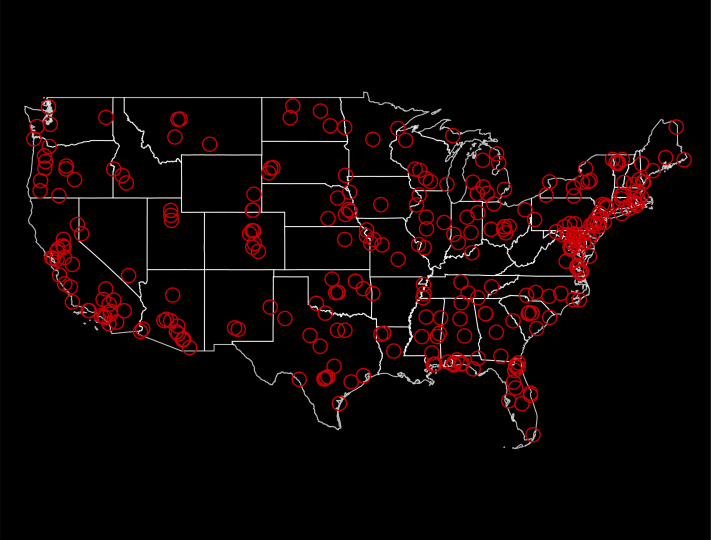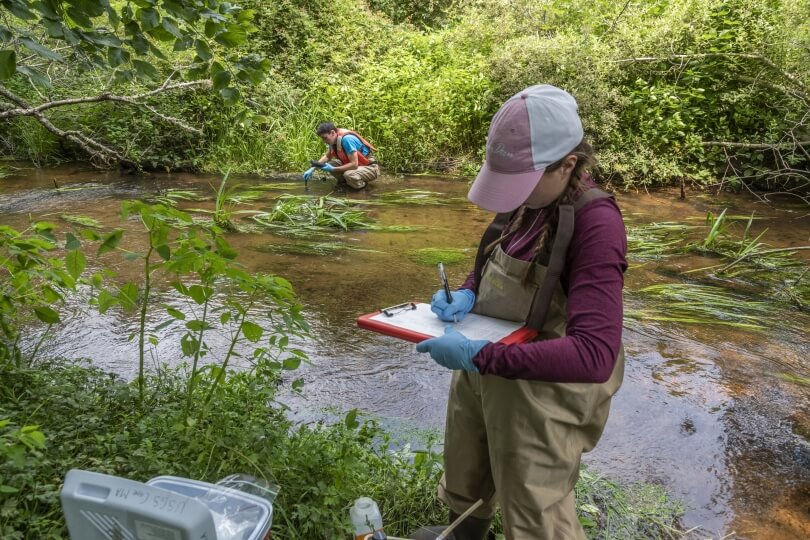News
Fish can accumulate high levels of per- and polyfluoroalkyl substances (PFAS), even far from sources of contamination, according to a new study by researchers at The Harvard John A. Paulson School of Engineering and Applied Sciences (SEAS). The research highlights the need for expanded monitoring in watersheds affected by large PFAS sources, such as military bases across the country that have been contaminated by the use of PFAS-containing foams for fire-training and firefighting activities.
Map of military bases in U.S. confirmed to be contaminated by the same types of PFAS as in this work. (Credit: Heidi Pickard/Harvard SEAS)
“This study underscores the urgent need for more comprehensive monitoring of PFAS in aquatic ecosystems, particularly in regions where freshwater fishing is an important food source for recreational and subsistence fishers,” said Elsie Sunderland, the Fred Kavli Professor of Environmental Chemistry and Professor of Earth and Planetary Sciences at SEAS and senior author of the study. “The public health risks posed by PFAS extend beyond immediate contamination sites and can affect communities living far from known sources. To protect these communities, it is crucial to measure PFAS in fish at sites that are hydrologically connected to known contamination sources and to develop consumption advisories.”
The research was published in Environmental Science & Technology.
PFAS, also called “forever chemicals” because of their persistence in the environment, are a family of thousands of synthetic chemicals widely used for their stain-resistant, water-resistant, and non-stick properties. They have seeped into our water, soil, and food, and can be found in more than 98-99% of Americans. While the Environmental Protection Agency (EPA) has established federal drinking water standards for six PFAS chemicals linked to adverse health outcomes, there are no federal guidelines for PFAS in food. The state of Massachusetts has recommended health-based consumption limits for one PFAS prevalently found in fish (PFOS), but measurements in the recent study show many others accumulate in fish tissues. Freshwater fish and shellfish, staples in many diets, often contain high levels of these “forever chemicals."
The research team examined fish and shellfish species collected from ponds, rivers, and bays on Cape Cod, Massachusetts, located downgradient of a military base that historically used PFAS-containing firefighting foams, known as AFFF (aqueous film-forming foams).
Heidi Pickard conducts fieldwork in the Santuit River on Cape Cod (Photo Credit: M. Salerno, URI STEEP Superfund Research Program)
“In the U.S., hundreds to thousands of military bases and airports have widely used AFFF for firefighting and fire-training purposes, leaving a legacy of contamination in many watersheds,” said Heidi Pickard (’24), who recently received her PhD at SEAS and is the first author of the paper based on her doctoral research. “While PFAS contamination in surface and groundwater near these sites is well-documented, less is understood about its effects on downstream ecosystems critical to recreational and subsistence fisheries.”
The results were striking: PFAS concentrations in fish tissues remained alarmingly high, even up to 8 km from the military base. Despite some decline in concentration with distance, fish fillet samples consistently exceeded state-level guidelines for safe fish consumption based on PFOS levels alone, without accounting for other PFAS identified in the samples.
The researchers found that a substantial portion of PFAS contamination remains undetected by conventional monitoring techniques, which typically target only a limited number of PFAS compounds. To fully grasp the scale of PFAS contamination and its risks, environmental monitoring programs and fish consumption advisories must include a wider range of PFAS compounds.
Cutting-edge science delivered direct to your inbox.
Join the Harvard SEAS mailing list.
Scientist Profiles
Elsie M Sunderland
Fred Kavli Professor of Environmental Chemistry and Professor of Earth and Planetary Sciences
Press Contact
Leah Burrows | 617-496-1351 | lburrows@seas.harvard.edu





